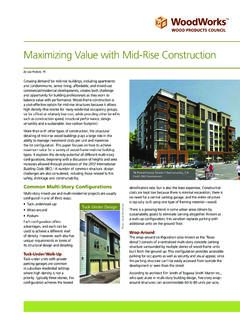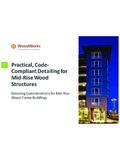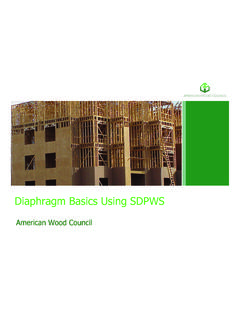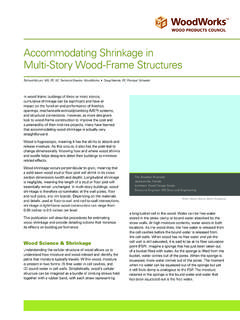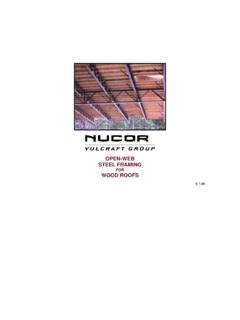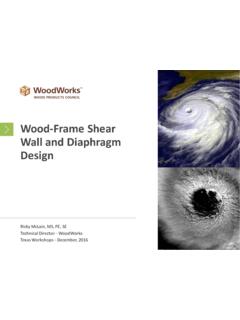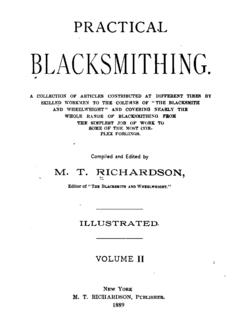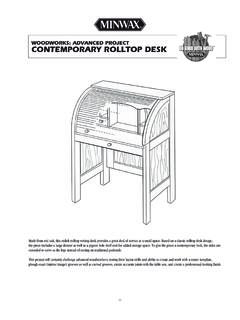Transcription of Timber Piling Design - WoodWorks
1 Timber Piling Design Presented by Martin Rollins, H. M. Rollins Company, Inc. for the Timber Piling Council The Wood Products Council is a Registered Provider with The American Institute of Architects Continuing Education Systems (AIA/CES). Credit(s) earned on completion of this program will be reported to AIA/CES for AIA members. Certificates of Completion for both AIA members and non-AIA members are available upon request. This program is registered with AIA/CES for continuing professional education. As such, it does not include content that may be deemed or construed to be an approval or endorsement by the AIA of any material of construction or any method or manner of handling, using, distributing, or dealing in any material or product. Questions related to specific materials, methods, and services will be addressed at the conclusion of this presentation. Copyright Materials This presentation is protected by US and International Copyright laws.
2 Reproduction, distribution, display and use of the presentation without written permission of the speaker is prohibited. The Wood Products Council 2012 Learning Objectives At the end of this program, participants will be able to: and Use the National Standards for Timber Piling Specify Timber Piling Specify the Preservative Treatment of Timber Piling and Use the Structural Strength Properties of Timber Piling Timber Piling Council The Timber Piling Council provides technical information, and promotes the use of Timber piles in the construction industry. The Timber Piling Council is administered by the Southern Pressure Treater s Association Photograph shows American Airlines Terminal at JFK where 11,000 Timber piles were installed. History Placing a log vertically into soft or unsuitable soil for a structural support is credited to Neolithic tribes around 6,000 years ago, in what is now Switzerland.
3 Homes were built on platforms supported by piles in lakes for protection from wildlife. Evidence of these structures still exists today. Roman Civilization Around 1620 , the Romans built a Timber bridge spanning the Tiber River which lasted over 1,000 years. Some roads and aqueducts were supported on Timber piles. They were still in good condition 1,900 years later. Roman Civilization Buildings in the Roman cities of Ravenna and Venice were built on wood piles from 100 to 400 The first bridge across the River Thames in London was built by the Romans about 60 on Timber piles. Today s Timber Piling Foundations for industrial and commercial structures Foundations for bridges and other infrastructure Ports and harbors Marine construction Raised coastal construction Industry Statistics 90% of Timber piles in North America are Southern Pine, the balance are Douglas fir. Preservatives used for Timber Piling are: chromated copper arsenate (CCA), creosote, and ammoniacal copper zinc arsenate (ACZA) (for Douglas fir).
4 Of Southern Pine piles, 95% are treated with CCA. Copper azole (CA) and ammoniacal copper quat (ACQ) are now approved for Southern Pine Piling . Foundation Piling Timber Piling resists attack from both alkaline and acidic soil. Corrosion protection is not required. Unaffected by electrolysis from stray electrical currents. Installs with standard, readily available equipment. Takes advantage of plentiful, renewable resource. Has lowest cost per ton of load carrying capacity of any deep foundation material, and is easy to install. Foundation Piling Foundation Piling Civil Infrastructure Timber pile supported embankment. Piles supported layers of geosynthetic material and compacted soil. Piles installed on grid about 9 each way. More economical than removing soil and replacing with compacted material. Marine Piling Resists battering by vessel impact, wind, wave, storms and tides as wood is a resilient material.
5 Excellent serviceability for port facilities, marinas, dolphins and fenders. Wood s high damping characteristics provide built-in shock resistance against hurricanes and earthquakes. Resort & Marina Design Chesapeake Bay resort has 140-slip marina with berths up to 65 ft. Marina 2,000 Timber piles, CCA treated pcf. Approach bridges Timber piles, heavy Timber framing, CCA treated pcf; roadway surface 3-inch decking. Golf course bridges similar construction with piles, timbers and decking. Tee supported on Timber piles. Aesthetically pleasing Coastal Design This house, built on piles in Pearlington, MS, is reported to be the only house that survived flooding from Hurricane Katrina. Water came within several inches of the pile girders, but never entered the house. Similarly constructed beach houses meeting coastal wind load standards line the coast from New Jersey to Texas.
6 Coastal Design Commercial structure in coastal flood zone How Do You Design Timber Pile Foundations? Timber Piling Manual Design Procedure. Foundation and Marine Piles. Timber Piling Data. Pile Group Design . Load Testing. Geo-technical Guidelines. Guide Specifications. Pile Installation. Timber Pile Foundations Piles are generally associated with difficult foundation conditions and weak sub-surface soils. Piles transmit forces from the super-structure to a lower stratum that has sufficient bearing value to support the completed structures and all applied loads. End-bearing piles primarily transfer loads through the tip. Friction piles primarily transfer loads through tangential skin friction. The natural taper of a Timber piles (1 change in diameter per 10 ft.), increases the friction reaction and is recognized in the Design formula. Tip Butt Design Values Piling Design values for normal load duration and wet conditions of use.
7 In pounds per square Property Southern Pine2 Douglas fir3 Compression Parallel to Grain, Fc 1,200 1,250 Extreme Fiber in Bending, Fb 2,400 2,450 Horizontal Shear, Fv 110 115 Compression Perpendicular to Grain, Fc 250 230 Modulus of Elasticity, E 1,500,000 1,500,000 Source: Values are from ANSI/AF&PA NDS-2005, National Design Specification for Wood Construction, Supplement for Timber Poles and Piles. 1 A form factor for bending members of circular cross section is incorporated in the allowable unit stresses for extreme fiber in bending listed in the table. 2 Southern pine values apply to longleaf, slash, loblolly and shortleaf pine. 3 Douglas fir values apply to Pacific Coast Douglas fir. Original Strength Development Historically, stresses were based on tests of small clear samples, adjusted for wood characteristics such as knots and knot clusters. ASTM Standard D2899 provides the procedure for developing working stresses from these tests.
8 Allowable stresses were originally developed by the Forest Products Laboratory. Full-Scale Testing Tests on full scale pile pieces were completed in 1999 and 2000. The tests were specifically conducted to develop Design stresses. They were run by EDM International of Ft. Collins, CO, an independent laboratory. National Design Specification Timber Piling Council full-scale testing program demonstrated that allowable stresses currently published in the widely recognized National Design Specification (NDS) are conservative. The tests also demonstrated that today s trees are just as strong as ever. The new ASTM standard, D7381, provides the protocol for developing stresses from full scale tests. Impact of New SPIB Design Values SPIB is in the process of lowering the Design values for Southern Yellow Pine lumber This is based upon more rapid growth Timber being used for lumber production ASTM D-25 contains growth rate limitations directly related to strength that have not changed ASTM D-25 requires a minimum of 6 growth rings in the outer one inch of the radius of the tip of Timber Piling and this requirement simply cannot be met by rapid growth material Therefore, the lowering of Design values for Southern Yellow Pine lumber will have no effect on the Design values for Southern Yellow Pine Piling , plus the recent full-sized testing has confirmed the existing Design values Piling Standards ASTM D25 prescribes whitewood requirements before treatment, such as dimensions, straightness, knot size and knot clusters.
9 American Wood Protection Association (AWPA) standards prescribe penetration and retention requirements based on type of preservative and exposure conditions. Original AWPA Standards based on performance of creosote. New preservatives have to be equal in performance. ASTM D-25 Class A and B Piling End Bearing- Natural Taper Friction Piling - Natural Taper AWPA Use Category System System simplifies use of AWPA Standards. UC 1 Interior construction, dry. UC 2 Interior construction, damp. UC 3 Exterior construction, above ground. UC 4 Ground and fresh water contact. UC 5 Salt water contact, marine construction. Piling are UC 4C and UC5 A,B or C Preservative Retentions CCA [pcf] ACZA [pcf] Creosote [pcf] Southern Pine Douglas fir Southern Pine Douglas fir Foundation Fresh Water Marine: Saltwater1 Marine: Saltwater2 Dual Treatment3 1 North of the New Jersey/Delaware border in the East, and north of San Francisco in the West.
10 2 South of the New Jersey/Delaware border in the East, and south of San Francisco in the West. Timber Piling Council members treat to this level, although AWPA Standards require less treatment north of this border. 3 Treatment for tropical water first treatment CCA, second treatment creosote. Today s Treating Plant The modern age of wood preserving began in England in 1832. The first treating plant in the was built in 1848. Today s plants have the latest in environmental protection features. Drip pads are protected from leakage with heavy duty liners below the concrete, and drippage is recaptured and recycled. Quality Control Before treatment, Piling are inspected and classified by size and conformance to ASTM D 25 Standards. Quality control inspectors at the plant monitor treating processes, sample and inspect Piling throughout the manufacturing process. After treatment, the Piling are checked for penetration and retention according to AWPA Standards.



